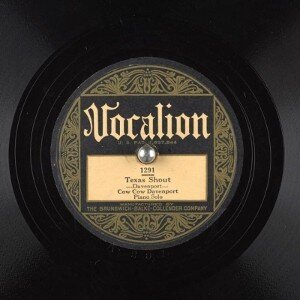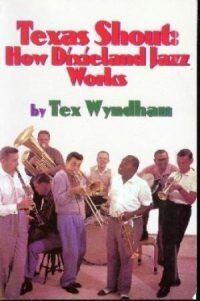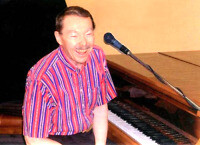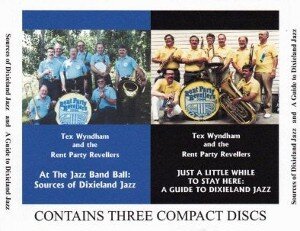 Set forth below is the fifteenth “Texas Shout” column. It first appeared in the March 1991 issue of the West Coast Rag, (now Syncopated Times.)
Set forth below is the fifteenth “Texas Shout” column. It first appeared in the March 1991 issue of the West Coast Rag, (now Syncopated Times.)
Because the column has not been updated, I should mention a source of Dixieland sheet music that has appeared since it was written. I acted as consultant on tune selection, and wrote the introduction for, a 1993 folio entitled The Definitive Dixieland Collection, containing 73 Dixieland evergreens (usually including the verse), over twice the number a Dixieland band would usually need to get through a typical four-hour gig. It remains readily obtainable from various online sources.
How to Improvise Solos
At Dixieland events I often find myself in discussions with fans who tell me that, years ago, usually at school, they played trumpet, clarinet, piano or some other instrument. I always ask if they still play. Upon hearing a negative answer, I urge them to get out the instrument and join the action. Typically, they respond in a friendly way, but with a noncommittal remark conveying the notion that they probably won’t do so.
Why don’t more Dixieland fans who’ve learned the basic rudiments of playing music try their hands at the idiom? There are lots of answers, of course. We all have our priorities, matters that make demands on our time and leave us less opportunity than we’d like to indulge our hobbies.
However, I can’t help but think that many would-be jazzmen are discouraged from trying to play by the gnawing fear that they will embarrass themselves in the process. They can get their old axes out of the closets — no trouble. They can find time to get their chops back into decent condition. They know a nearby jazz club that sponsors open jam sessions at regular meetings. But — they can’t face what might happen on that first tune when they have to play a solo in front of other musicians and an audience of jazz fans.
I guarantee that the room will be filled with people who are on your side in such a situation. All the other performers went through the same process, and all the fans want to encourage new talent to play their favorite music.
You will be applauded. No one will laugh at you. However, that information may not be quite enough for you, because you still want to have some basis for believing, before you take that step, that you can meet some minimal standards, that you won’t be off in left field somewhere.
If you are in this category, I am going to try to use today’s column to help you. Without taking you through detailed, theoretical analyses of the music, I will give you a procedure to follow that will enable you to improvise a solo that will sound O.K. There are other ways of teaching this same skill, and mine is just one of them, but it will work.
I am assuming that you know how to play your instrument in the sense that you are able to sound the notes and know which notes you’re sounding. That is, if I tell you to play a B-flat (written “B♭”), you can do so.
On that basis, for each of the twelve notes of the tempered scale, you should learn one scale and five chords. They are set forth below in the key of B♭:
◆B♭ scale = B♭, C, D, E♭, F, G, A and B♭ played in that order or in reverse order.
◆B♭ major chord (referred to as merely a “B♭” chord in fake books or chord charts) = B♭, D and F, sounded simultaneously.
◆B♭ minor chord (B♭m) = B♭, D♭ and F, sounded simultaneously.
◆B♭ seventh chord (B♭7) = B♭, D, F and A♭, sounded simultaneously.
◆B♭ diminished chord (B♭dim or B♭°) = B♭, D♭, E and G, sounded simultaneously.
◆B♭ augmented chord (B♭aug or B♭+) = B♭, D and F-sharp (written “F#”), sounded simultaneously.
To discover the notes in the scale and the chords in the other eleven keys, transpose the foregoing data up and down the keyboard. It might help to write this information down on a piece of paper for each key.
You will eventually need to memorize this scale and these chords for each key, knowing them so well that they’ll pop into your mind automatically when you think of the basic note (referred to as the “tonic” note — B♭ in the above example). However, so that you can get started, Dixielanders should learn the scale and the chords for the twelve keys in the following order: B♭, F, E♭, C, A♭, G, D♭, D, G♭, A, E, B.
That suggested order is given because it goes from the most common keys used by Dixieland bands to the least common. The vast majority of Dixieland tunes are played in B♭, F and E♭, while almost none are played in D, G♭, A, E and B. However, you will need to learn the scale and chords for all twelve keys because there will be occasions, even when playing in B♭, F and E♭, that you will encounter parts of tunes constructed on the tonic notes of A, E, B and the others.
Similarly, concentrate at first on learning the notes in the major, minor and seventh chords. Many Dixieland songs do not use either diminished chords or augmented chords. Of the two, the diminished chord is much more common than the augmented chord.
Advanced forms of jazz, and occasionally some Dixieland tunes, use more sophisticated chords. You may sometimes see notations for sixth, ninth, eleventh and other chords.
However, for purposes of Dixieland jazz, stick to the five chords I’ve mentioned. Any others, should you encounter them in a Dixieland context, will still sound O.K. harmonized with these five.
In order to begin improvising a solo, you’ll need to know the chord pattern of the tune you’re playing. As an example, let’s use the basic twelve-measure, or twelve-bar, blues in B♭. The most common form of that tune has the following chord pattern:
The “/” tells you to play another beat of the chord you’ve been playing, i.e., “B♭///” means the underlying chord for all four beats in that bar is B♭.
Note that each of the twelve bars has four beats. All Dixieland tunes have four beats in each bar.
Of the four beats in each measure, the first and third beats are, in Dixieland jazz, strong beats in feeling. The second and fourth beats are weaker in feeling.
That situation means that a discordant note (one not in the underlying chord) will make more of a clash — will be more likely to sound “wrong” — if it is heard on the first or third beat. An out-of-chord note heard on the weaker beats will not clash, but will create tension in the listener’s mind which the listener will expect to hear resolved on the next strong beat.
Now you’re ready to construct your solo. For each bar, regardless of the key signature of the tune, pay attention only to the underlying chord or chords. Construct a melody that will have, on the first and third beats, a note in the underlying chord being sounded. To close the gap between such notes, use notes in the scale of the tonic note of the underlying chord.
To illustrate: In our twelve-bar blues, you might start the first beat of the first bar with a B♭ note, one of the notes in a B♭ major chord. Let’s say you’ve decided to work toward D, another note in a B♭ major chord, as the note you’ll hit on the third beat. How should you fill the time between the B♭ you’ll hit on the first beat and the D you’ll hit on the third beat? You may do so any way you want to, provided you use only the notes B♭, C, D, E♭, F, G, A and B♭. Got it?
Your transition notes can be quick ones, long ones, repeated ones, linear (along the scale), in leaps (jumping up and down between notes on the scale), anything you wish. Whatever you choose will sound O.K. against a Dixieland rhythm section, as long as it uses only notes in the B♭ scale.
I recommend that you try this system out while practicing along with records. I have practiced along with records all my life. It’s a great way to train your ear to hear chord changes, to learn tunes, to get a clearer understanding of what’s going on in the band, and to try out some licks that the other musicians are using — all in a context where you’re by yourself and can’t be embarrassed. When you think you’ve got the basics, you’re ready to try a live jam session.
When you get into a jam session, don’t make the mistake many newcomers make regarding repertoire. They’re afraid to admit they don’t know the tune or the key that someone has suggested. They think they can “ear it in” after the first chorus. Instead, they wind up in over their heads.
Not even professionals will go on stage in front of an audience and try to play tunes with which they are unfamiliar. If you don’t know a tune, or you don’t feel comfortable trying the one mentioned, or you are uncertain about the key, say so and the band will pick something else (or you can suggest an alternative). Nobody will hold it against you for wanting to play material that puts you at ease.
I can’t emphasize this point too strongly. There are thousands of tunes to play, and you’re only going to be playing five or six of them during the set, so don’t try to be a hero. If it makes it easier for you, say that Tex Wyndham told you not to try that tune until you’ve learned it better.
Now assuming that you’ve memorized your scales and chords, and have some records with which to practice, how do you learn what the chord patterns of the tunes are? This can be a tough question in today’s scene, where it is relatively difficult to locate music stores that stock any tunes from the early years of the century, let alone some of the Dixieland tunes that did not become hits with the general public.
However, many of the local jazz clubs have “fake books” that contain “lead sheets” (the melodies and related chord patterns) for standard Dixieland tunes. Perhaps you can obtain access to a copy.
Similarly, many Dixieland jazzmen possess such books. Perhaps a musician friend may be in a position to help.
Although Chuck might wind up bombarded with calls as a result of this reference, try contacting Charles B. Anderson. Chuck is a retired musician and music collector who has been most helpful to many Dixielanders in the past by steering them toward sources of lead sheets.
Ed. Note: Mr. Anderson has passed since this column was published but his legacy continues in a fake book containing 9339 songs on 6797 pages in 21 packets. See Yestertunes.com
The system I have just outlined calls for steady and dedicated work on your part. It will not turn you into the next Louis Armstrong via two weeks of five-minutes- a-day practicing. (For perspective, although I work a full-time nonmusical job, I play my cornet nearly every day with a recording, a procedure which consumes about 60-75 minutes total, including warm-up.)
However, if you want to participate in the considerable joys of playing Dixieland jazz, and you’re willing to put in some time, this system will do the job. It will bring you to the point where you’ll be able to get into a jam session with some confidence that you’ll leave the stage with a sense of having made a positive contribution.
The system has a name. Musicians call it “chord-running” or “running the changes.”
As you may have gathered, chord- running is a by-the-numbers, take-no- chances, play-it-safe, non-creative way to improvise. If you never learn to do anything other than run chords, you will never be regarded as anything other than a plain-vanilla-style Dixielander. However, on today’s scene, there are many instrumentalists out there, some of them with very popular bands, who have scarcely gone beyond running chords and reworking favorite licks. You can have a lot of fun without being the next Sidney Bechet.
Moreover, and this is the important thing, if you pay attention to what you’re doing, and listen closely to those records as you play along, you will gradually learn when you can step away from the mechanical rules of chord-running, when you can set up those clashes on the strong beats, when to play notes that aren’t in the scale or the underlying chord, when to keep the listener in suspense via a silent passage and then sweep him up with a fleet run, etc. You will do what all good jazzmen should do: find your own individual voice and your own vision of the material.
In the process, you’ll be playing Dixieland jazz — some of the most satisfying kind of music that there is — playing an important role in keeping it alive as an art form, and earning audience applause. Have I got any takers?
Next time we meet at a Dixieland show, instead of mentioning that you used to be a musician, tell me that you read this column, dusted off your instrument, learned some tunes, played along with some records, jammed with other musicians, and are having a ball keeping the flame burning. You’ll make my day.
Back to the Texas Shout Index.

The full run of “Texas Shout” has been collected into a lavishly illustrated trade paperback entitled Texas Shout: How Dixieland Jazz Works. This book is available @ $20.00 plus $2.95 shipping from Tex Wyndham, On request, Tex will autograph the book and add a personalized note (be sure to tell him to whom the note should be addressed).
Tex Wyndham’s 3 CD Guide to Dixieland with music and commentary is available for $20 plus $2.95 shipping. The separate CD, A History of Ragtime: Tex Wyndham Live At Santa Rosa, is available for $13.00 plus $2.00 shipping. On request, Tex will autograph the inner sleeve and add a personalized note (be sure to tell him to whom the note should be addressed).
Send payment to Tex Wyndham, P.O. Box 831, Mendenhall, PA 19357, Phone (610) 388-6330.
Note: All links, pictures, videos or graphics accompanying the Shouts were added at the discretion of the Syncopated Times editorial staff. They did not accompany the original columns and do not necessarily reflect the opinion of Tex Wyndham.
From roughly 1970-2010, Tex Wyndham was: (1) one of the best-known revivalist Dixieland jazz musicians in the US, as cornetist, pianist and bandleader, (2) one of the best-known ragtime pianists in the US, and (3) one of the most respected critics in the US of Dixieland jazz, ragtime, and related music. He is the only person about whom all three of those statements can be made.




